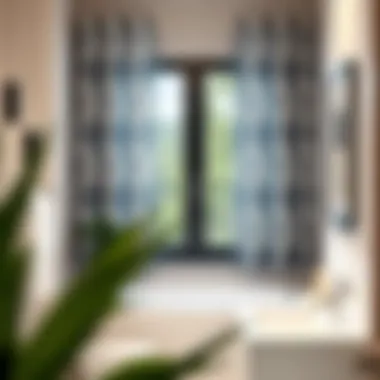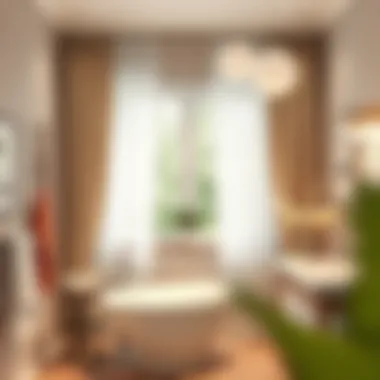Maximize Space with Short Curtains for Small Bathrooms


Intro
In the realm of bathroom design, small spaces often present unique challenges, particularly when addressing the need for both function and aesthetics. Short curtains emerge as a stylish solution, offering homeowners a way to manage light and privacy without overwhelming a compact area. This article delves into the nuances of incorporating short curtains into small bathroom windows, focusing on how these fabric adornments can amplify both visual appeal and usability.
Several factors come into play when selecting the ideal short curtains for a small bathroom; from style and fabric to maintenance and light control. Moreover, it’s not just about the curtains themselves, but how they interrelate with existing decor and functionality of the space. Homeowners, designers, and DIY enthusiasts alike can all benefit from a deeper understanding of what makes short curtains the unsung heroes of bathroom design.
Let’s embark on this journey where we uncover practical tips, stylish designs, and thoughtful measures for maximizing your small bathroom space with the right short curtains.
Understanding the Importance of Short Curtains
In the world of interior design, small spaces often call for clever solutions. Short curtains hold significant sway in the realm of bathroom windows, where functionality meets style. These window coverings not only serve practical purposes but also contribute to the overall atmosphere of the room.
Maximizing Space in Small Bathrooms
The size constraints of a small bathroom can feel stifling; this is where short curtains shine. Rather than overwhelming the space, they help maintain an airy feel. Hanging curtains that end well above the windows and do not drag on the floor creates an illusion of height. This tactile visual trickery makes even the tiniest of bathrooms seem more expansive.
Furthermore, short curtains avoid collecting dust and moisture at the lower edges, which is common in bathrooms. This is particularly crucial for maintaining hygiene in a damp environment. By keeping things airy and easy to clean, you support a healthier atmosphere for daily routines. Some may think that curtains in small bathrooms are superfluous, but those with keen design eyes understand that they are a clever blend of style and utility.
Enhancing Aesthetic Appeal
The role of short curtains goes beyond mere functionality; they can truly transform the aesthetic of a room. Color, texture, and pattern choices are vast, allowing homeowners to express their unique taste. Think about the freshness of light cotton in a soft pastel hue that effortlessly complements tiled walls, or a bold geometric print that becomes an eye-catching statement piece against a monochrome color scheme.
Moreover, well-chosen short curtains can pull together the entire look of a bathroom. They act as a unifying element, orchestrating harmony between various features, such as cabinetry, fixtures, and tiles. For instance, if your bathroom showcases modern lines, sharp colors can accentuate that contemporary vibe well while subtly breaking up the abruptness of hard surfaces. When it comes to aesthetics, short curtains are a quintessential piece that can make or break the room’s feel.
Integrating short curtains can surprisingly elevate both the charm and functionality of small bathroom spaces.
Choosing the Right Fabric
Selecting the right fabric for short curtains is a step that significantly sways not just the look, but also the functionality of your small bathroom. The fabric choice impacts everything from durability to how much light can filter through. In a small space where every detail counts, choosing the appropriate fabric can help make or break the overall ambiance.
Lightweight Materials
Opting for lightweight materials is often a smart move for bathroom curtains. Fabrics like sheer cotton or lightweight linen allow sunlight to spill into the room while providing a veil of privacy. They flutter beautifully in even the slightest breeze and don't overwhelm compact spaces. A finely woven fabric can create an airy feel, making your small bathroom appear more spacious.
Moreover, these materials are easy to maintain. They usually withstand regular washing quite well and dry quickly, which is a critical factor for spaces exposed to moisture. A few examples of lightweight fabrics include voile, which can give a soft sheen, and muslin, known for its breeziness.
Water-resistant Options
In bathrooms, considering water-resistant fabrics is crucial. Your curtains need to withstand the environment without growing mold or contributing to excess humidity. Fabrics like polyester and nylon are often treated to be water-resistant, making them viable options. A water-resistant curtain will help maintain the aesthetics of your bathroom while also contributing to the longevity of the fabric.
Additionally, opting for water-resistant materials requires minimal cleaning effort, as splashes and moisture won't leave stains that are hard to remove. This can save you time and prevents the need for frequent replacements, creating a win-win situation both for the pocket and the eye.
Textured Fabrics for Added Style
When it comes to enriching the visual interest of short curtains, don’t overlook textured fabrics. Options like bamboo, jacquard, and corduroy can add depth and style to your bathroom's decor. The interesting patterns and textures can create a sense of luxury or warmth, depending on your selections. Imagine a lush, rich fabric contrasting with smooth tiles and a crisp vanity! The right texture can tie different elements of the bathroom together beautifully.
Examples of Textured Fabrics:
- Bamboo: Eco-friendly and natural, providing a unique finish.
- Jacquard: Features intricate patterns without overwhelming the space.
- Corduroy: Adds a casual, inviting feel that softens the hard lines of a small bathroom.
Determining the Right Length
Finding the right length for short curtains is key to getting that perfect blend of functionality and style, especially in a small bathroom. Short curtains are not just about aesthetics; they play a significant role in how space feels and functions. The right length can help to create an illusion of bigger windows and also maximize light, which is an essential factor in a bathroom where moisture can easily become a problem.
When dealing with small windows, the measurements you choose can either open up the room or make it feel cramped. An appropriate curtain length will allow you to enjoy privacy while still benefiting from natural light. It also reduces the accumulation of moisture on fabrics, preventing mildew, a common concern in bathroom settings. The key to making your choice is understanding both standard window sizes and the option for custom lengths to match your unique decor.


Standard Measurements for Small Windows
Generally, standard bathroom windows are between 24 to 36 inches wide and 36 to 48 inches tall. For a short curtain, you typically want to choose a length that sits just above the window frame or sill. Here's a more in-depth look:
- Sill Length (About 6 inches below the top of the window frame): This length is great for casual settings and easily manageable when cleaning, as no fabric drapes onto the sill.
- Apron Length (About 12-18 inches below the top of the window frame): This option provides a bit more privacy while still letting light spill into the bathroom, making it a popular choice among decorators.
Using a measuring tape is crucial. Measure from the top of the window casing down to where you want the curtains to fall, accounting for hardware height.
Custom Length Options
Custom lengths can be an excellent solution when standard measurements don't quite fit, which may often be the case in smaller, uniquely shaped bathrooms. Here are a few points to consider when going down the custom route:
- Precision is Key: When ordering custom curtains, always double-check your measurements. A slight inaccuracy can lead to a poor fit.
- Style Considerations: You can choose how high above the window to position the curtain rod, thus affecting the visual perception of height in the room. Hanging curtains a bit higher can create the illusion of taller windows.
- Flexible Fabrics: Custom options often allow for tailored lengths that can incorporate different designs and materials to play into the aesthetic of the bathroom. For example, a fabric that just grazes the sill can feel tailored and elegant.
In many cases, opting for custom lengths can lead to a more personalized space, reflecting the homeowner's unique style while ensuring the functional needs of the bathroom are met.
"Curtains can be more than just a decorative touch; they’re an essential part of your bathroom’s character."
Whether you’re choosing standard or custom lengths, the goal remains the same: to create a harmonious space that balances both functionality and design.
Exploring Design Styles
When it comes to decorating small bathrooms, short curtains aren't just about function; they’re also an opportunity to express personal style and complement the overall decor. The right design style can transform an ordinary space into something extraordinary. Through thoughtful choices in style, homeowners can create a cohesive aesthetic that marries form and function. Different design styles can offer unique benefits, such as maximizing light, providing privacy, and enhancing the overall feel of the room. Understanding these styles is key to making informed choices that suit both personal taste and practical needs.
Modern Minimalism
Modern minimalism is all about creating a sleek, uncluttered look that emphasizes simplicity. For small bathrooms, this style is ideal as it promotes the idea of less is more. Short curtains in subtle colors and light fabrics generate a clean aesthetic without overwhelming the space. Think of sheer white or gray panels that gently diffuse light while maintaining a sense of openness.
- Clean Lines: The focus is on simple, straight designs that eschew ornate patterns or excessive ruffles.
- Neutral Color Palettes: Using whites, beiges, and soft grays creates a serene environment, allowing for relaxation.
- Functional Decor: Every piece in a modern minimalist bathroom serves a purpose. Short curtains should enhance functionality while appearing effortless.
This style is not only visually appealing but also encourages an atmosphere of calm, which is often what one seeks in a small bathroom.
Classic Elegance
Classic elegance brings a timeless sophistication that can complement any bathroom, no matter its size. With short curtains tailored from rich fabrics like jacquard or silk blend, this style can elevate even the most understated shower area. The elegance lies in the details—subtle patterns or intricate trims can add depth without being too overpowering.
- Rich Textures: Think velvet or silk blends that catch the light beautifully.
- Traditional Patterns: Floral or damask patterns often evoke a sense of luxury and can be seamlessly integrated into the decor.
- Color Coordination: Deep hues like navy, burgundy, or forest green can make the space feel more inviting.
This classic approach allows homeowners to incorporate short curtains that harmonize with other elegant features such as vintage fixtures and high-quality finishes.
Playful Patterns and Colors
The playful patterns and colors approach is for those who want to bring a bit of fun into their small bathroom. It encourages creativity and boldness, breaking away from the ordinary and celebrating individuality. Vibrant prints, quirky designs, and bright colors can truly express personality and create a cheerful environment.
- Bold Color Choices: Choosing bright yellows or cheerful blues can instantly lift the mood of the bathroom.
- Unique Patterns: Geometric or whimsical prints engage the eye and can serve as a focal point in a small space.
- Mix and Match: Don’t shy away from combining patterns within the bathroom's decor, such as striped towels with polka dot curtains.
This design style invites homeowners to experiment, leading to a bathroom that feels uniquely theirs. It reflects a carefree spirit that can make daily rituals enjoyable.
Tip: When using patterns, keep the rest of the decor simpler to ensure a well-balanced appearance that isn’t too overwhelming.
In summary, each design style offers distinct benefits and aesthetics for short curtains in small bathrooms. Whether a homeowner leans towards modern minimalism, classic elegance, or playful patterns, there are ample options to explore. By combining these styles effectively, you can create a vibrant and functional small bathroom that feels expansive and stylish.
Installation Tips
Choosing the Right Rod or Track
The curtain rod or track you choose plays a vital role in both aesthetics and functionality of your curtains. A sturdy and stylish rod can elevate the visual element of your bathroom, while a functional track ensures smooth operation. Here are some factors to consider:


- Material: Opt for durable materials like stainless steel or wrought iron that can handle the moisture typical in bathrooms without rusting.
- Design: Choose a rod that complements the existing fixtures in your bathroom. If your bathroom embraces a minimalist feel, a sleek, simple rod may be best. On the other hand, if the decor is more opulent, consider ornate designs.
- Length: Ensure that the rod extends beyond the window frame by at least a couple of inches on either side. This approach allows more light in when the curtains are open and creates an illusion of a larger window.
- Brackets: Consider the weight of your curtains and choose brackets that can support them adequately. Strong brackets will ensure the rod stays securely in place, even on the most humid days.
Proper Mounting Techniques
Once you have the rod or track selected, it’s time to move on to the installation process. Well-mounted curtains not only deliver better performance but also prevent any potential mishaps, such as unexpected falls. Here’s a simple guide to proper mounting techniques:
- Measure Twice, Mark Once: Start by measuring the height you want the curtains to hang. A good rule of thumb is to install the rod about four to six inches above the window frame for that visual lift.
- Use a Level: To ensure your rod is straight, use a leveler while you mark the drill holes. Nothing says ”amateur” like curtains hanging lopsided.
- Drill with Care: Create a pilot hole in the wall. If you hit a stud, you might not need a wall anchor, but if you’re drilling into drywall, anchors are essential for support.
- Tighten Securely: Once the brackets are in place, firmly attach the curtain rod. This ensures that it can handle the weight of the fabric without sagging over time.
- Test the Operation: Hang your curtains and run them back and forth a few times. This step is crucial to ensure they glide smoothly and provide the intended functionality.
"Installing curtains may seem trivial, but the details matter; they can truly tie a room together, or fall flat if done incorrectly."
Maintenance and Care
Maintaining short curtains in small bathrooms is not merely about aesthetics; it is an essential step that contributes to their longevity and functionality. In spaces that may experience fluctuations in humidity or splashes from daily activities, prioritizing cleaning and care ensures your curtains remain both visually appealing and practical. Establishing a regular maintenance routine can also help in avoiding stains and wear, which is particularly crucial given the confined nature of smaller bathrooms.
Cleaning Strategies for Bathroom Curtains
Cleaning short curtains requires a bit of know-how, as depending on the material, methods can vary. Here’s a quick rundown of strategies for effective cleaning:
- Regular Dusting: Use a feather duster or a vacuum with a brush attachment to remove dust and debris. This can be done monthly or whenever you notice a buildup.
- Spot Cleaning: If you encounter stains, it’s wise to treat them promptly. Use a mild detergent mixed with water, applying it with a clean cloth to the stained area. Rinse with a damp cloth, making sure no soap residue remains.
- Machine Washing: If your curtains are machine washable, use the gentle cycle with cold water. Avoid using harsh detergents, as they can damage delicate fabrics. Always check the care label for specific instructions.
- Drying Properly: If you prefer air drying, hang them right after washing to minimize wrinkles. Alternatively, if you do use a dryer, select a low heat setting to prevent shrinkage.
"An ounce of prevention is worth a pound of cure." Keeping your short curtains clean can save you from hefty replacements down the line.
Conditioning Fabrics for Longevity
To prolong the life of your short bathroom curtains, conditioning the fabric is critical. By applying the right treatments, you can enhance their durability, color retention, and resistance to water-related wear.
- Fabric Softeners: When washing, consider using a fabric softener. This can not only make the curtains feel softer but also help in maintaining their shape and resilience against wrinkles.
- Stain Guard Treatments: After washing, apply a fabric protector spray designed for upholstery. It creates an invisible barrier against moisture and stains, which is particularly beneficial in a bathroom setting. Make sure to follow the instructions carefully for optimal results.
- Rotating Usage: If your curtain style permits, consider having a second set. Rotating them can minimize wear-and-tear, giving each set time to recover and prolonging their overall life.
Adhering to these maintenance and care guidelines will ensure that your short curtains not only enhance your small bathroom's aesthetics but also stand the test of time.
Light Control and Privacy Considerations
In small bathrooms, the interplay between light control and privacy can make a significant difference. Short curtains serve a dual purpose by allowing a degree of light to filter in while also providing shielding from the outside world. Achieving the right balance ensures that the space remains bright and welcoming yet intimate, which is especially crucial for smaller areas where cramped feelings can easily arise.
Translucent vs. Opaque Fabrics
When selecting short curtains, one must first consider the type of fabric that aligns with the desired light control and privacy levels. Translucent fabrics, such as sheer cotton or linen blends, can create an airy atmosphere, allowing sunlight to seep through while diffusing harsh glare. This kind of fabric transforms your bathroom into a bright retreat, making it feel larger than it is due to the natural light.
However, there is a flip side. Translucent options do not offer much privacy, especially at night when interior lights are on. In those cases, opaque fabrics like blackout curtains or heavier materials are advisable. These options, while restricting light to some extent, provide complete coverage and ensure that prying eyes cannot see in.
Key Points to Consider:
- For a Bright Space: Choose translucent fabrics to maximize natural light.
- For Privacy: Opt for opaque materials, especially in urban settings or areas with close neighbors.
Layering Options for Enhanced Privacy
An effective trick to navigate the nuances of light and privacy is through layering. Combining different curtain types can be a game changer. For instance, installing a lightweight sheer curtain behind a thicker fabric can give the best of both worlds.
By using this method, you can allow filtered light to pour in during the day, creating a serene ambiance. When it comes time for privacy, simply draw the heavier curtain closed to shield the space from outside view.
Utilizing dual rods provides flexibility; you can easily switch between a light, airy feel and snug, cozy privacy without any hassle.
Benefits of Layering:
- Versatility: Use sheer for daytime softness, switch to heavier for nighttime needs.
- Control Over Brightness: Adjust light entry based on your preference.
- Aesthetic Appeal: Adds depth and texture to your bathroom design—creating visual interest.


"In a small bathroom, the right blend of light control and privacy can redefine your daily routines, adding a touch of comfort and style."
Through thoughtful selection of fabrics and exploration of layering techniques, small bathrooms can achieve an ideal balance between natural light and seclusion. By doing so, homeowners can create spaces that are both functional and inviting.
Incorporating Curtains with Bathroom Decor
When it comes to small bathrooms, every detail matters, and incorporating short curtains is no exception. The decision to use curtains should not merely be about practicality; it’s also an opportunity to elevate your bathroom’s design. Curtains can serve as a silent statement piece, unifying various elements while adding both functionality and flair.
Color Coordination with Wall Paint
The hues of your short curtains should dance harmoniously with the walls of your bathroom. If you've got a lighter shade on your walls, such as soft peach or creamy white, consider curtains in deeper tones like teal or navy to create a striking contrast. This can bring depth to the room or vice versa, opting for pastel curtains against a richer wall color to soften the overall appearance.
Here are some insightful tips to achieve optimal color coordination:
- Choose complementary colors: For a bold look, pick colors opposite on the color wheel. If your walls are in a warm tone, cool-toned curtains can balance the warmth.
- Stick to a palette: Utilize various shades within the same color family. This method can create a layered aesthetic that feels well-planned without being too matchy-matchy.
- Test samples: Don’t just go with your gut. Use swatches for curtains against the wall to understand how natural light affects the hues at different times of the day.
Merging Patterns for Cohesive Design
Patterns in your curtains can introduce vibrance to your small bathroom. However, this can also be a tricky path to navigate. The key lies in knowing how to merge patterns without creating visual chaos.
Here’s how you can blend patterns for a cohesive look:
- Mix prints wisely: If your shower curtain or bath mat has a busy design, opt for solid-colored short curtains. Conversely, if your other elements are neutral, don’t shy away from patterned curtains that echo the themes present elsewhere in the room.
- Select a unifying theme: Geometric patterns can pair with other geometric designs, while floral patterns can blend smoothly with soft botanical prints. Having a common theme allows them to coexist without clashing.
- Layer patterns gently: Use different fabrics in varied prints simply by layering. For example, sheer patterned curtains can hang behind thicker, solid-colored panels to soften a bold color scheme while maintaining visual interest.
In essence, incorporating curtains with your bathroom decor requires thoughtfulness and a touch of creativity. The ability to coordinate color and merge patterns can breathe life into a small bathroom, making it a place of both function and aesthetic appeal. So, as you approach your curtain choices, consider how they can reflect your style and complement the overall design of the space.
Trends in Short Curtain Designs
As the world increasingly emphasizes sustainable living, short curtains are no exception to evolving trends. They not only serve practical purposes but also reflect a growing consciousness regarding environmental impact and modern living conveniences. In this section, we’ll dive into two prominent trends: sustainable and eco-friendly curtains, as well as smart fabrics and technology integration, both of which cater to homeowners and designers striving for both style and functionality.
Sustainable and Eco-friendly Curtains
The demand for sustainable and eco-friendly materials in home decor has skyrocketed recently. Homeowners are opting for curtains made from organic cotton, linen, and hemp, which are both biodegradable and environmentally friendly. Using these materials means contributing to a healthier planet, often while also enjoying added benefits of durability and texture in one’s home.
- Benefits: These fabrics tend to have a lower environmental impact compared to conventional textiles, which may rely on harmful pesticides and synthetic processes. Additionally, many eco-friendly options are treated with non-toxic dyes, safeguarding both health and the environment.
- Considerations: When selecting sustainable curtains, look for certifications such as GOTS (Global Organic Textile Standard) or OEKO-TEX, which ensure a product is safe and environmentally friendly.
Incorporating eco-friendly curtains into small bathroom windows not only enhances the aesthetic but also resonates with a broader trend towards sustainable living.
Smart Fabrics and Technology Integration
The realm of home decor is now intertwined with technology more than ever, and curtains are not left out of this integration. Smart fabrics incorporate advanced technology that can significantly enhance the functionality of short curtains. Imagine having the ability to adjust your bathroom curtains with just a touch of a button or set them to open and close automatically based on natural light levels or privacy needs.
- Benefits: These innovative curtains can come with features such as temperature regulation, where textiles respond to changes in heat or light, helping maintain a comfortable bathroom environment. Additionally, you can find options with built-in sensors for privacy and light control that make daily routines smoother.
- Considerations: While investing in smart curtains may carry a higher initial cost, the long-term benefits in energy savings and convenience often outweigh the investment. It’s worth researching compatibility with existing home automation systems for seamless integration.
Adopting these modern trends not only elevates the functional capacity of small bathroom windows but also contributes significantly to creating a more sustainable and tech-savvy living space.
"Investing in trends like eco-friendly materials and smart technologies can transform small bathrooms into havens of style and efficiency."
As these trends continue to evolve, homeowners and designers are increasingly equipped to make decisions that marry aesthetics, practicality, and conscientious living.
Final Thoughts on Short Curtains for Small Bathrooms
Short curtains help in optimizing limited wall space while still providing enough coverage to maintain privacy. They allow natural light to flood the room without feeling too heavy or obstructive. Moreover, these curtains can enhance the aesthetic appeal, offering an opportunity to play with various textures, colors, and patterns. When getting into the nitty-gritty, one must consider how light, color, and fabric interrelate to impact the overall ambiance.
The selection process should be well thought out to align with the bathroom's design elements and personal taste. The materials you choose can dictate the durability and maintenance required over time. For example, lighter fabrics can create a breezy feel while also being easy to wash. Conversely, more robust materials offer longevity but may require a bit more elbow grease to keep clean.
"Short curtains can dramatically change the vibe of a small bathroom, marrying form with function in a harmonious manner."
Making informed choices regarding fabric, style, and length is crucial. Think about your bathroom's current color palette and how these curtains will blend with other décor elements. What textures coexist well with tile, wood, or metal fittings? Besides aesthetics, you want to ensure that functionality—like light control and moisture resistance—remains intact.
In essence, short curtains are more than curtains; they are a valuable asset that can maximize space, contribute to a cohesive design, and enhance comfort in small bathrooms. By adhering to the tips and insights discussed throughout this article, you empower yourself to make choices that will uplift the space while maintaining its core function.
Remember, a well-designed bathroom is not merely about aesthetics; it’s about creating a retreat where every element—from the curtains to the smallest decorative item—works in concert. Planning accordingly can yield a space that feels less cramped and more inviting, completing the vision you have for your personal sanctuary.















